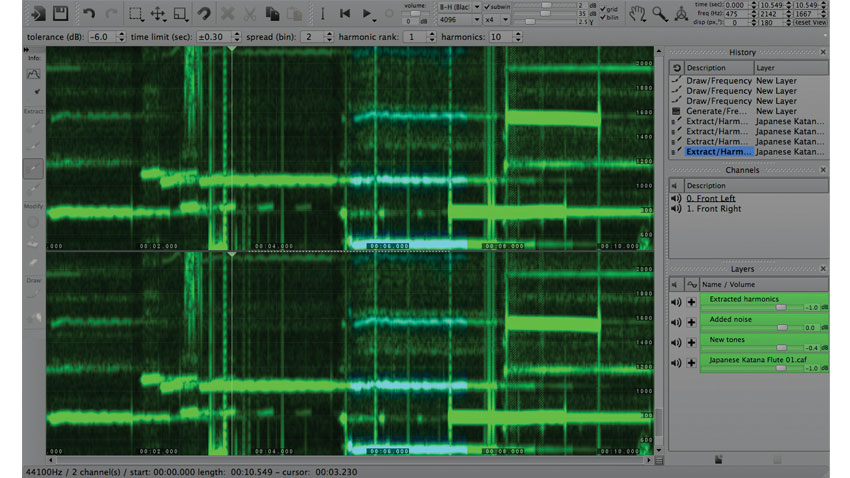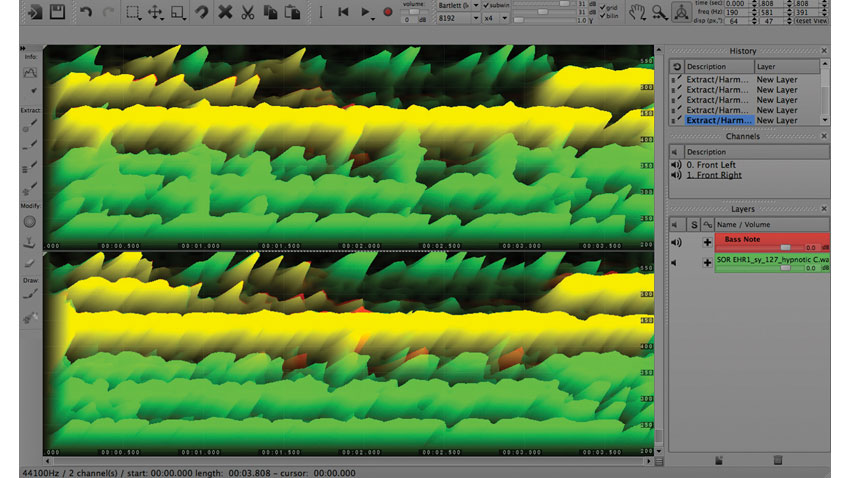MusicRadar Verdict
Powerful but overly fiddly, SpectraLayers can give some amazing results if you've got the patience for it.
Pros
- +
Useful harmonics extraction tool. Good for removing material from audio. Potentially creative feature set. Mono and stereo supported.
Cons
- -
Requires a powerful machine. Linear frequency scaling is annoying. Some features are pretty tough to exploit accurately.
MusicRadar's got your back

Sony Creative Software SpectraLayers Pro

3D Displace
The release of SpectraLayers was actually first announced last year by French company Divide Frame, but following a deal with Sony Creative Software, Robin Lobel's app now joins established packages such as Sound Forge and ACID under the Sony banner.
The first things Sony did were to simplify the version roster (there's now just the fully featured 'Pro' one), and ditch multichannel support. In all other respects, the new owners' influence seems to have been kept very low key.
Photoshop for audio?
SpectraLayers is a standalone application into which you load mono or stereo audio files (in any of a huge range of compatible formats), which are analysed, then displayed in spectral form, with time along the bottom axis and frequency on the vertical. Stereo channels can be viewed one above the other or side by side.
SpectraLayers has a lot in common with other layer-based graphical applications, such as Adobe Photoshop. Your base file, which you can either import or record directly into SL, forms your fundamental layer. You then create additional layers, copying and pasting between them to make complex sounds.
In addition to activating, deactivating, labelling and soloing these layers, you can also phase reverse them and adjust their levels. This means you can both add audio layers together and subtract them from each other (using phase reverse), and even, impressively, carry out said operations on specific frequency ranges using the various selection tools.
"The real power of SpectraLayers lies in its editing tools - making accurate selections is easy"
When you've created the sound you want, you simply merge the layers and render the whole mix. Colour coding is used throughout the process (green for active layers, red for soloed or selected ones), and this is augmented by further colours that are brought into play when you copy layers to the clipboard.
However, the real power of SpectraLayers lies in its editing tools. The basic ones (Select, Move and Scale) enable you to select, copy, cut, move and stretch sections of the spectral display. With the tools also available in 'frequency-only' and 'time-only' versions, making accurate selections is pleasingly easy.
Want all the hottest music and gear news, reviews, deals, features and more, direct to your inbox? Sign up here.
So far so good, but also slightly restrictive, as the selected areas must be square or rectangular. For more precise selection, you get a further set of extraction tools (Area, Frequency, Harmonics and Noise), which enable direct extraction of more precisely shaped elements to a new layer.
"With the frequency scale being linear, we found ourselves having to zoom in and out far too much"
So that's how you select and extract areas from the source file, but what can you actually do with them? The main tools let you reposition and pitchshift selected areas of the spectrum, and beyond that, three modify tools (Amplify, Clone and Eraser) facilitate more precise changes.
However, in use, we found that these could be tough to actually use accurately. In part, this is because, although you can audition selected sections, it can still be difficult to visually distinguish what's what. And with the frequency scale being linear - as opposed to logarithmic, like most spectral analysers and editors - we found ourselves having to zoom in and out far too much, as the vast majority of what we were interested in was stuffed into about a third of the display.
That said, once you get past the operational hurdles, what SL does do rather well, as shown in Sony's own demos, is remove sonic elements that you don't want. By extracting areas to new layers and using the layer phase reverse function, you can very successfully remove specific pitches, noises or, with the excellent Harmonics selector, more complex sounds. Once again, success is entirely dependent on your ability to select the offending frequencies, and that can take time. Once that's done, though, the results are often excellent.
Getting creative
As well as editing existing audio, you can also use SpectraLayers to create audio from scratch using a pair of drawing tools: Noise and Frequency. Noise is the more flexible of the two, as it includes extra options for tailoring the pen type, but between the two you can summon all sorts of crazy sounds, ranging from simple tones to sharp bleeps, pitchbends and noise sweeps. It's an unexpected bonus for those who like to design their own FX hits, sweeps, and all manner of other far-out sounds.
Rounding things off, SpectraLayers also supports VST plug-ins. These operate as offline effects, which are previewed, then rendered. Not ideal, then, and the interface is nothing like as slick as its equivalent performing the same operations in Sound Forge - but at least plug-ins are supported.
Initially, we had a slightly bumpy ride with SpectraLayers, particularly in terms of getting to grips with the toolset and graphical display. From a purely sonic perspective, it does what it does incredibly well, but the operational aspects are key to a package like this, so it's a little disappointing that a few balls appear to have been dropped.
First, although the frequency scale can be labelled in notes, octaves or Herz, the linear scaling just isn't suited to a musical context, where a logarithmic scale makes total sense. Secondly, we found the selection tools and screen grid hard to see at times, and with no user settings with which to adjust this, you're stuck with what you're given.
Finally, having a fast computer with a decent graphics card is a must. Anything less will slow you down, turning SpectraLayers' creative audio manipulation into a painful waiting game. In summary: amazing results are certainly possible, but getting there can be a grind.
Computer Music magazine is the world’s best selling publication dedicated solely to making great music with your Mac or PC computer. Each issue it brings its lucky readers the best in cutting-edge tutorials, need-to-know, expert software reviews and even all the tools you actually need to make great music today, courtesy of our legendary CM Plugin Suite.
